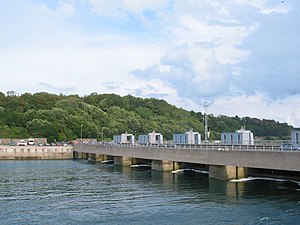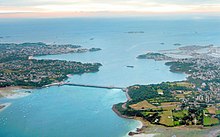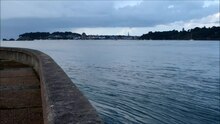Usine marémotrice de la Rance
| La Rance tidal power station | |||
|---|---|---|---|
| Tidal power plant in the area of the barrage | |||
| location | |||
|
|
|||
| Coordinates | 48 ° 37 '4 " N , 2 ° 1' 29" W | ||
| country | France | ||
| Waters |
Atlantic Ocean (+ Rance ) |
||
| Data | |||
| Type | Tidal power plant | ||
| Primary energy | Hydropower | ||
| power | 240 MW installed (68 MW average) |
||
| operator | Electricity de France | ||
| Project start | 1961 | ||
| Start of operations | 1967 | ||
| turbine | 24 Kaplan turbines of 10 MW each | ||
| Energy fed in 1985 | 611 GWh | ||
The Usine marémotrice de la Rance ( Breton Stankell vorredan ar Renk ) is a tidal power station built in 1966 in a dam design at the mouth of the Rance River between Saint-Malo and La Richardais (near Dinard ) in the Ille-et-Vilaine department in Brittany in North West France . The power plant draws most of its energy from the tidal currents of the Atlantic , which at this point has a tidal range of over eight meters. A significantly smaller proportion of its performance comes from the flowing current of the river mouth.
The power plant first fed electricity into the grid in 1967, making it the first commercially used tidal power plant in the world. With its total peak output of 240 megawatts , it was by far the largest power plant of its kind in the world for more than 40 years (ahead of the tidal power plant Annapolis , Canada, with only approx. 20 MW). In August 2011, it was replaced by the Korean plant Sihwa-ho as the record holder for peak output (with 254 MW).
history
Long before the 20th century, there were tidal mills in Brittany, especially along the Rance, that used the force of the tides to drive millstones and other machines.
The proposal to use the strong tides in the region to generate electricity on a large scale was first made in 1921. From 1925 there was a test facility in the small town of Aber Wrac'h near Landéda , but it was shut down again five years later due to financial problems. From 1943, the Société d'étude pour l'utilisation des marées (German: Study Society for the Use of Tides ) carried out a detailed study on the construction of a tidal power station at the Rance estuary.
It then took almost 20 more years before construction actually began in 1961 under the leadership of Albert Caquot . A section of the Rance estuary was drained by means of two temporary retaining walls made of huge concrete cylinders, and from 1963 the current shut-off structure with the power station was erected in the resulting tub. This lasted three more years until the dam was inaugurated on November 26, 1966 by French President Charles de Gaulle . In the following year, 1967, the road over the dam was also opened for passage and on December 4, 1967, the power plant fed electricity into the national EDF network for the first time .
As a unique engineering structure, the power plant has long been a tourist attraction in itself. It attracts around 200,000 visitors annually.
technology
The bay of the Rance estuary, separated from the open sea by the power station, has an area of around 22 km² and a storage volume of around 180 million m³. At the maximum tidal range, 720 million m³ of water flow through the power plant with every tide, which corresponds to an average flow of 15,000 m³ / s (only tidal current; not counting the current of the river).
The 750 m long shut-off structure built for the power plant consists (from west to east) of a 65 m long and 10 m wide lock structure for shipping, a 390 m long concrete dam into which the machine house for the 24 turbines integrated, a dam 175 m in length and a 115 m wide barrage , consisting of six sections, through which the tidal flow past the power plant can be regulated.
The structure can be driven over, route départementale No. 168 between Dinard and Saint-Malo crosses the Rance in this way. In the area of the lock there is a bascule bridge that allows larger ships to pass through. Around 16,000 ships and boats pass through the lock every year; over the road at peak times up to 35,000 vehicles per day.
The 24 turbines are Kaplan bulb turbines with a horizontal shaft and a rotor diameter of 5.35 m. With a maximum flow of 275 m³ / s and a maximum speed of 260 min −1 , each turbine delivers an electrical output of up to 10 MW. The blades can be rotated by 40 ° in order to be able to adapt to the changing requirements: The turbines function in both directions of flow (at ebb and flow) to generate electricity, but also as pump turbines , so that the power plant can also be used as a pumped storage power plant. About 20% of the time the system works in pumping mode, 60% in turbine mode. Furthermore, the turbines can also work in "push mode" in order to offer as little resistance as possible to the flow when required and to quickly empty or fill the reservoir to support the weir. Due to the wide range of requirements, a comparatively low level of efficiency had to be accepted.
The generators, which are rigidly coupled directly to the turbine, are three-phase synchronous machines with a voltage of 3.5 kV. The generators are connected in groups of four and feed the energy into the 225 kV high-voltage network via three block transformers with an output of 80 MVA each (3 · 2 · 4 = 24).
In order to protect against chemical attack by seawater, an elaborate cathodic corrosion protection had to be provided, which is operated with 1 V voltage and 20 amperes of current. Corrosion-resistant materials had to be installed in the entire system - as is usual in the area of influence of seawater - and special emphasis had to be placed on sealing.
Ecological impact / criticism
Although the power plant still allows a considerable tidal current to flow through, the barrier structure has noticeably changed the ecosystem of the Rance estuary. The tidal range in the estuary, which was up to 14 m before the construction of the power station, has now been reduced to approx. 7–8 m and has been postponed.
- The removal of sediments and mud from the Rance to the open sea was hindered to such an extent that the Rance estuary was massively silted up .
- There is no special facility to facilitate the passage of fish through the power station dam. Smaller fish, and even the most sensitive cuttlefish (squid) can usually pass unharmed relatively slowly rotating turbines. The migration between the reservoir and the open sea is only impeded for large species such as seals and porpoises .
- The influx of sea water when the tide came in was reduced to such an extent that the salinity of the water in the Rance estuary decreased noticeably. As a result, some saltwater fish such as sand eels and plaice have completely disappeared. Some fish species, whose stocks temporarily declined after construction ( sea bream , mullets , rays , ...), have now repopulated the reservoir. On the other hand, some brackish and freshwater fish have even increased.
Individual evidence
- ↑ Under the supervision of Robert Gibrat , who is considered the father of tidal power plants; consulting architect was Louis Arretche , cf. Dominique Amouroux: Louis Arretche . Infolio, 2010, p. 92.
- ↑ a b The functionality of a tidal power plant at www.telta.de/jopetri ( Memento of the original from April 15, 2008 in the Internet Archive ) Info: The archive link was automatically inserted and not yet checked. Please check the original and archive link according to the instructions and then remove this notice.
- ↑ K. Graw: USE OF TIDEENERGY - a short introduction , 2001, on www.uni-leipzig.de ( Memento from March 20, 2007 in the Internet Archive )
- ↑ Alexandre Pigeard: L'Usine marémotrice de la Rance ( Memento of May 5, 2006 in the Internet Archive ) (PDF, French)





